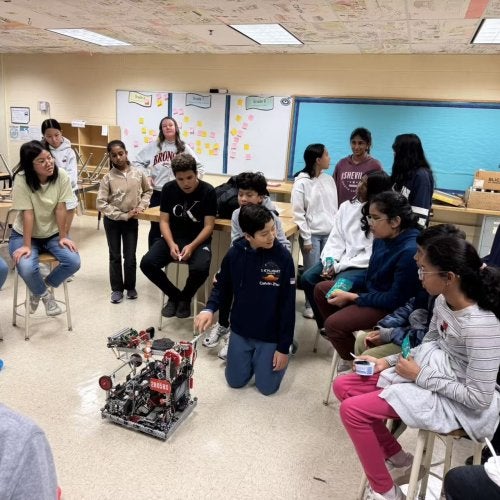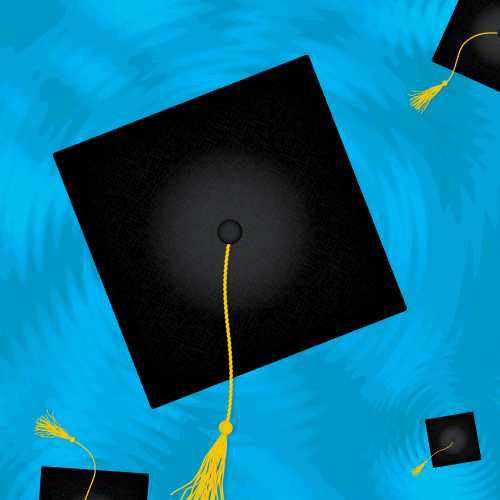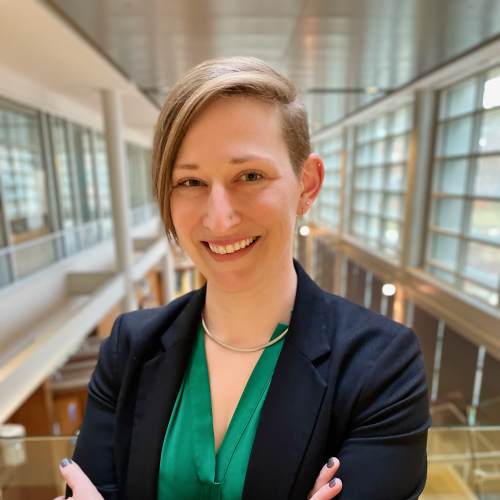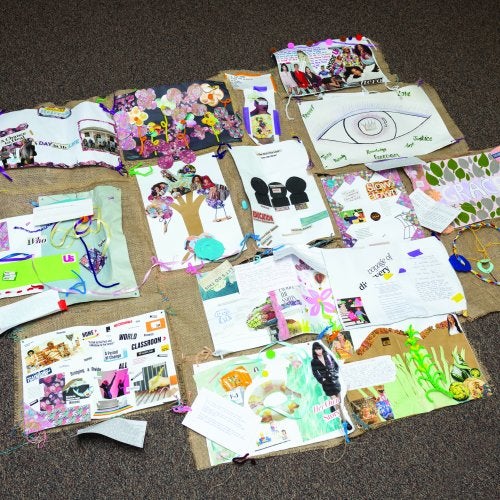WEB NEWS RELEASE
College of Education takes the initiative in the global growth fields of science, technology, engineering and mathematics
COLLEGE PARK, MD (December 2009) - If you want to grow with the future needs of the nation and the world, you need STEM: Science, Technology, Engineering and Mathematics.
The acronym has become a clarion call for a multiplicity of today's and tomorrow's needs: increased intellectual rigor; the ability to successfully compete for jobs; addressing climate change; combating disease; creating green industries; ending hunger; fueling innovation. STEM is globally understood to be a crucial part of social and economic progress in this century. The National Academies' 2005 report, Rising Above the Gathering Storm, declared STEM an urgent priority for the United States and called for the nation to educate 10,000 new science and mathematics teachers.
The University of Maryland College of Education is coming on strong in STEM initiatives -- even in ways you might not expect. From brain imaging to recruitment of top scientists as middle school teachers, the College is firmly, and sometimes quietly, taking the lead nationally in the effort to promote and strengthen STEM in education. Dean Donna Wiseman is the University's liaison to the Science and Mathematics Teacher Imperative (SMTI), a national collaboration of more than 100 public universities and university systems committed to increasing the quantity, quality, and retention of new science and mathematics teachers. Wiseman is also Maryland's team leader in The Leadership Collaborative (TLC), a group of 27 institutions drawn from universities making the commitment to SMTI. TLC, with a $1.5 million, three-year grant from the National Science Foundation's Math and Science Partnership, aims to enable universities to overcome constraints that often limit effective and sustained preparation of secondary science and math teachers.
Wiseman has those same ambitions for coordination and visibility of STEM commitments right here on the Maryland campus. "We want to increase the number of people who go into STEM professions, period," she says. "We are also very interested in that area for women and minorities. We have so many tremendous resources in these fields here at the University, we need to pull all of that together. Together we have more impact than we do separately."
Wiseman would like a full-time STEM education coordinator who will work with other colleges on campus to promote the recruitment and preparation of mathematics and science teachers. "So often, each of the colleges on campus works as its own silo," she says. "SMTI requires that we break out of those silos and work in partnership. That's going to be good for everyone on campus: working together to recruit, train and support teachers."
The efforts of which Wiseman speaks are indeed dramatically varied, creative, and often not sufficiently heralded. Following is a brief tour of the College's STEM initiatives:
Maryland Science Mathematics Resident Teacher (MSMaRT) Program
MSMaRT does what many a public school system wishes a program would do: it recruits and trains math and science middle-school teacher candidates, chiefly career-changers, who are familiar with the communities surrounding high-needs schools in their jurisdiction and are motivated to work with the students there, many of whom come from low-income and otherwise difficult situations. MSMaRT is a new partnership between the College and Prince George's County Public Schoolsan urban school district that has found it difficult to recruit and retain certified mathematics and science teachers for middle school.
"We try to get candidates who live in or near Prince George's County who have a reasonably strong math and science background," says Andrew Brantlinger, an assistant professor in Mathemtatics Education and the Principal Investigator on the grant for MSMaRT. "There is a fair amount of research to show that they're the ones who are most likely to stick around if you prepare them well. They have work experience and have probably experienced struggle at some point in their lives, unlike like many new teachers right out of college."
MSMaRT has started recruitment of teacher candidates, who will undergo 11 weeks of training. Brantlinger says the program's entire staff and the Prince George's Public Schools system are excited about what MSMaRT can accomplish.
"It's one thing to study schools as an academic, as I have, but it's another to take what you've learned and put belief into practice. MSMaRT is a way for us to do something that can have a positive impact on high-needs schools. It's one of the reasons I'm fortunate to be at Maryland; most mathematics education programs don't focus on urban education."
Transition from Laboratory to Classroom (TLC)
"The idea behind TLC," explains Department of Curriculum and Instruction faculty member Kathleen Travers, who coordinates the program, "is to bring in true experts in science who want to change careers and teach children: people who have laboratory experience but also have an ability to convey very complex ideas and innovative thinking about science to students in public schools. It's a rare person who can step out of the lab into teaching in this way. So we started in 2003 to recruit people who can."
We're talking scientific heavyweights here. One was a NASA scientist who ended up teaching at an aerospace magnet school and also redesigning a curriculum there to reflect breakthrough science. Another was a patent attorney with a physics background who discovered his love for teaching while volunteering on weekends to do science demonstrations for children at the Smithsonian. Now, as a public school teacher, he not only teaches science but also the principles of intellectual property and how to patent ideas.
"These are people who really want to teach," says Travers. "They have a love of kids, but being in the laboratory as a career is not people-oriented. What a lot of our candidates have said is, 'I want human contact. Science is a dynamic, alive field, but in the lab I don't feel as if I'm talking to anybody.'"
A partnership between the College of Education, the National Institutes of Health (NIH), and Montgomery County Public Schools, TLC recruits through the NIH, scientific conventions, and word of mouth among scientists. So far 13 candidates from a variety of prestigious scientific institutions have gone through the TLC teacher training program, which covers tuition and provides a stipend. More and more applications come in as word about the program spreads, says Travers, but TLC deliberately keeps the program small to carefully screen for candidates it knows will succeed as teachers.
"It's been very successful," she says. "Montgomery County is thrilled. Our graduates can bring to the classroom a scientific world that's real, not some outdated software package that's 10 years old that just happened to be in the media center. This is the real stuff.
Center for Mathematics Education (CfME)
With more than a 50-year history at the University of Maryland, CfME is both a unit of the College's Department of Curriculum and Instruction (EDCI) and a university-wide center (http://education.umd.edu/EDCI/MathEd/).
"At the heart of what we do at CfME," says Center Director Daniel Chazan, an associate professor in Curriculum and Instruction, "is research on the teaching and learning of math in urban schools." CfME is the lead institution in the Mid-Atlantic Center for Mathematics Teaching and Learning (MACMTL). MACMTL supports doctoral students and two large research projectsone led by Chazan, developing case studies of teachers in majority-African-American local schools; another by Associate Professor Patricia Campbell, studying relationships between teacher knowledge and student achievement. There are also other faculty projects, such as Assistant Professor Andrew Brantlinger's research on the New York City Teaching Fellows program, Chazan's studies examining the use of animations as representations of classroom interaction, and Campbell's study of a Virginia initiative that prepares coaches for elementary mathematics teachers.
In addition to existing programs for the certification of elementary and secondary teachers at both the undergraduate and graduate levels, CfME also has other STEM initiatives regarding teacher preparation, including:
- A collaboration between the Department of Mathematics in the College of Computer, Mathematical and Physical Sciences and EDCI to create a new program to certify middle-school mathematics teachers (the University of Maryland already certifies for elementary and high school mathematics). In addition, spearheaded by Assistant Professor Ann Edwards, faculty in the Center and in EDCI have collaborated in a Department of Education grant proposal to support strengthening the in school components of this new certification program.
- A collaboration with the Mathematics Department on outreach to elementary math teachers in Montgomery and Prince George's counties seeking the above certification to teach grades four through nine. These efforts are coordinated by Dr. Beatriz Quintos and have been supported with three grants from the Maryland Higher Education Commission.
- A federal grant to support collaboration with Prince Georges County Public Schools on the creation of a program (MSMaRT) for post-baccalaureate certification as middle grades mathematics teachers. Faculty from CfME (Whitney Johnson and Rick Holenbeck) currently instruct mathematics courses offered in the mathematics department designed specifically for pre-service teacher candidates.
- A coming together of mathematics teacher educators from across Maryland, spearheaded by CfME alumni, to found an organization focused on increasing the number of mathematics teachers across the state.
Chazan, who is on sabbatical this year (CfME's acting director is Assistant Professor Lawrence Clark), says CfME's work is crucial at this moment in time when our society is exploring "how to adequately prepare high school students for college or for work after high school. Our society is asking kids to know more and more about math. This is an important moment in mathematics education."
Brain Imaging Center
Back in what Donald Bolger calls the "flag-planting" era of MRI (Magnetic Resonance Imaging) brain scanning in the 1990s, it was a breakthrough to simply be able to physically see, for the first time, which areas of the brain were associated with which functions.
But today's brain imaging technology is so advanced that we can not only see much more of what particular portions of the brain do, we can even watch how specific activities in the brain act over time. Which means we can now literally watch, within the brain, how the progression of a given brain activity is linked with the progression of a child's developmental behavior, or with the progress of a disease, or with the evolving reaction of a person to his or her environment.
"Today, for example, we can look at such questions as, 'Why is it that children as they move toward adolescence are more impulsive, less likely to control certain behaviors?'" says Bolger, an assistant professor of Human Development. "We can start to look at what is happening in the brain, what is firing, what is being engaged as a person makes these decisions, and how this brain activity changes in adolescence."
As most brain imaging today focuses on adults or on diagnosing disease, it is a rare brain imaging center indeed that uses this astonishing technology to study human growth and development.
Now the University of Maryland will have one that does.
Having received $2 million in grant funding from the National Science Foundation in September, the University is racing ahead with a Brain Imaging Center that it plans to have up and running by the summer of 2010. The Center will be built around a 14-ton, 10-foot-long high-resolution Siemens Trio MRI scanner, acknowledged as the industry standard for quality, and will include a physicist, administrative staff, and technicians, as well as faculty. Principal Investigator on the NSF grant is Distinguished University Professor Nathan Fox of the College's Department of Human Development, who will also head the executive committee overseeing the Center.
Despite the many brain centers at top universities, explains Bolger, "What is unique about our center is the top-notch researchers we have here who expressly focus on human development and on linguistic processing, and who will use our center to look at developmental populations and at linguistic issues. Ours will be a top brain center in these areas."
The Center will also teach courses on MRI research, and will sponsor an on-campus summer conference every year on leading MRI-based scholarship. Most importantly, it will be a home for some of the world's most advanced research in aspects of brain function.
Leigh Abts, Research Associate Professor
Leigh Abts is seemingly a one-man STEM campaign. A research associate professor in the College of Education with an affiliate professorship in the A. James Clark School of Engineering, Abts is an educator, an engineer, an inventor (he holds a number of patents) and a tireless advocate for STEM education, both in the academy and in Washington, D.C.
He has a contract with the Office of the U.S. Secretary of Defense to assist in the development of a Strategic Plan for STEM Education. He has also secured a planning grant from the Kern Family Foundation to develop a rubric for an electronic portfolio to be used by students doing engineering and design projects. In fact, he plans to assemble a group of researchers, educators, engineering faculty, and teachers from around the country to help create this rubric.
Abts's other initiatives include:
- Working with the National Federation of the Blind this past summer to bring nearly 200 blind high school students from around the country to the UM campus to pursue STEM activities in career areas to which blind students routinely do not have access, such as architecture. The students worked with nearly 100 blind mentors in various professions.
- Serving on the Steering Advisory Committee for the Congressional STEM Caucus, which advises the Caucus on holding events on Capitol Hill to brief Congresspersons and their staffs on STEM-related issues.
- Creating an early college programthrough funding from the Woodrow Wilson Gates Foundationthat offers UM courses, primarily in engineering and STEM education, at the Friendship Public Charter Schools in Washington, D.C. This enables students, primarily in high school, to take undergraduate courses for credit. These include a course developed and taught by the College's Department of Counseling and Personnel Services that teaches Friendship students how to successfully choose undergraduate courses and majors, consider careers, and employ effective study habits.
Abts is also working, at Dean Donna Wiseman's request, on fostering a close working relationship between the College of Education and the School of Engineering.
"As far as I know," he says, "this is the first time the College of Education and the School of Engineering have worked together at this level. I think the 'Two Es' make a very powerful combined force."
To Wiseman, all of the above-mentioned efforts, as well as others like the College's Science Teaching Center and UM's Terps Teach program -- an initiative that will recruit mathematics and science majors to become teachers, offering them experiences in public school classrooms during their freshman and sophomore years -- represent the kinds of STEM advances she sees as crucial.
"It's important for us to take the lead here in Maryland," she says. "There is such an urgent need for good teachers in the areas of science, technology, engineering and mathematics, and this is so connected with future workforce and societal issues. If we don't have good teachers in these areas, we are missing the core element of what is needed."
-end-
For more information on the College of Education, visit: www.education.umd.edu
or contact Halima Cherif, Assistant Director for Communications, at: hcherif@umd.edu



